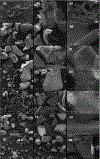Effects of different drying methods on the physicochemical properties and antioxidant activities of isolated acorn polysaccharides
- PMID: 35238861
- PMCID: PMC6309185
- DOI: 10.1016/j.lwt.2018.10.027
Effects of different drying methods on the physicochemical properties and antioxidant activities of isolated acorn polysaccharides
Abstract
Our earlier studies showed that the Acorn Polysaccharides (AP), as a forest byproduct, have a good prebiotic properties and antioxidant activity, hence can be used as an ingredient to produce functional foods. Three drying methods (freeze, hot air and vacuum drying) in different temperatures were comparatively studied on the physicochemical properties (solubility, water and oil-holding capacity [OHC/WHC]), bioactivity (resistance to acidic and enzymatic digestions, effect on a probiotic strain growth) and antioxidant activity of AP along with the structural changes. Results suggest that the drying methods in combinations of temperatures and time of drying process affect physicochemical properties, antioxidant activity and bioactivities of AP. Freeze dried AP exhibited the highest solubility, WHC, OHC and antioxidant activity, digestibility with simulated gastrointestinal juices and fermentable by a Lactobacillus plantarum. Whereas, hot air dried (80 °C) exhibited second highest antioxidant and functional activities like solubility, WHC, OHC and fermentation. FTIR analysis showed that the changes caused by varying drying methods of AP starch are related to its amorphous or crystallinity structure and differences in functional group. Overall, these results suggest that freeze drying and hot air drying at 80 °C can be appropriately use to obtain a functional polysaccharide from acorn, as a prebiotic (resistant starch).
Keywords: Acorn; Drying; Functional properties; Polysaccharide; Prebiotic.
Figures







 Step 1: Simulated gastric fluid, pH 1.2 (SGF).
Step 1: Simulated gastric fluid, pH 1.2 (SGF).  Step 2: Mixture of simulated gastric and intestinal fluid, pH 4.5 (SMF).
Step 2: Mixture of simulated gastric and intestinal fluid, pH 4.5 (SMF).  Step 3: Simulated intestinal fluid, pH 7.4 (SIF) and α-amylase. Values presented in bars are the average of triplicate experiments and error bars represent SD. The column not followed by the same letter are significantly different in the same digestion step with p < 0.05 level of significance, according to LSD Test.
Step 3: Simulated intestinal fluid, pH 7.4 (SIF) and α-amylase. Values presented in bars are the average of triplicate experiments and error bars represent SD. The column not followed by the same letter are significantly different in the same digestion step with p < 0.05 level of significance, according to LSD Test.References
-
- Akbari-Alavijeh S, Soleimanian-Zad S, Sheikh-Zeinoddin M, & Hashmi S (2018). Pistachio hull water-soluble polysaccharides as a novel prebiotic agent. International Journal of Biological Macromolecules, 107, 808–816. - PubMed
-
- Amid BT, & Mirhosseini H (2012). Optimisation of aqueous extraction of gum from durian (Durio zibethinus) seed: A potential, low cost source of hydrocolloid. Food Chemistry, 132(3), 1258–1268. - PubMed
-
- Betancur-Ancona D, Peraza-Mercado G, Moguel-Ordonez Y, & Fuertes-Blanco S (2004). Physicochemical characterization of lima bean (Phaseolus lunatus) and jack bean (Canavalia ensiformis) fibrous residues. Food Chemistry, 84(2), 287–295.
-
- Boler BMV, & Fahey GC Jr. (2012). Prebiotics of plant and microbial origin. In Callaway TR, & Ricke SC (Eds.). Direct-fed microbials and prebiotics for animals (pp. 13–26). New York: Springer.
Grants and funding
LinkOut - more resources
Full Text Sources
